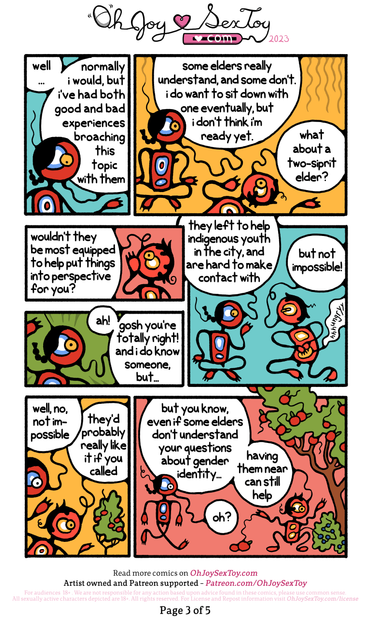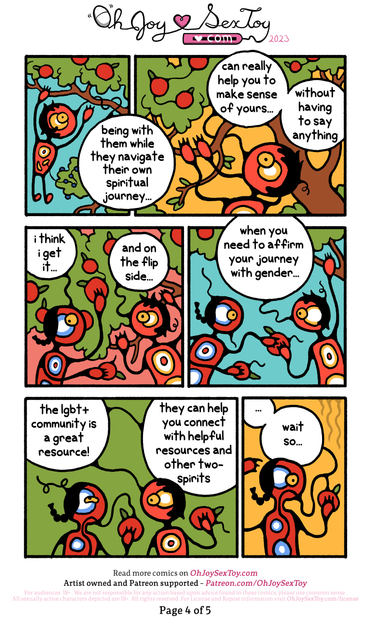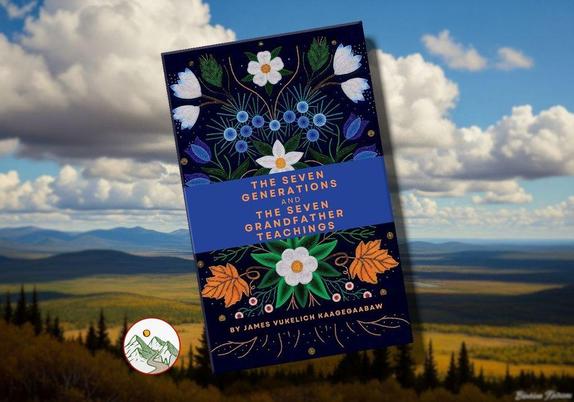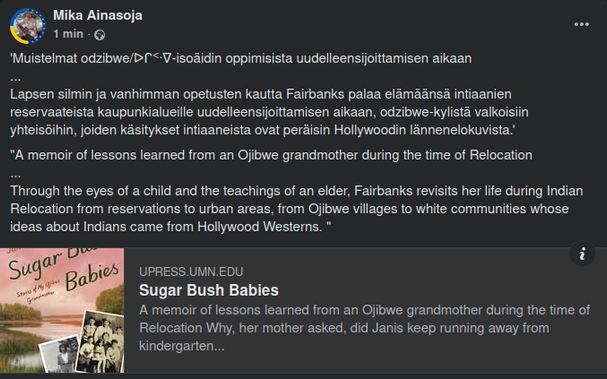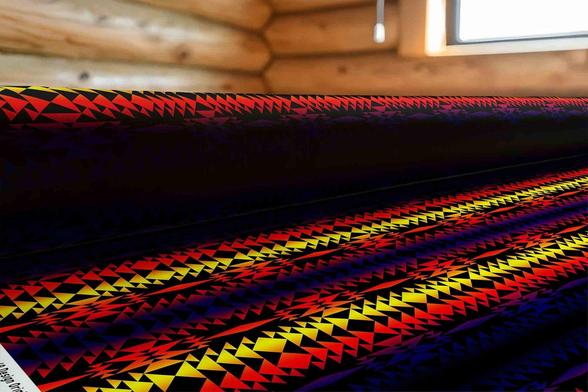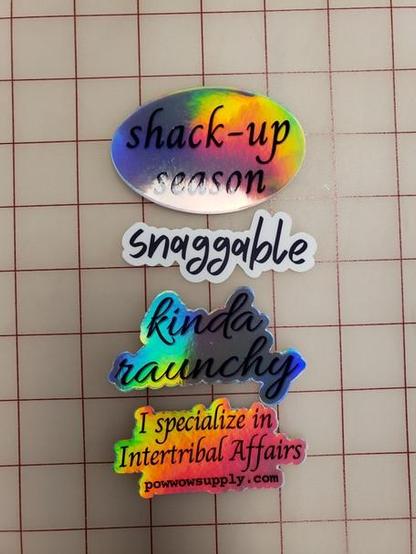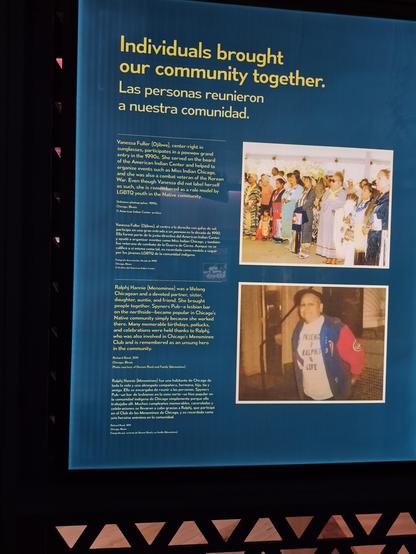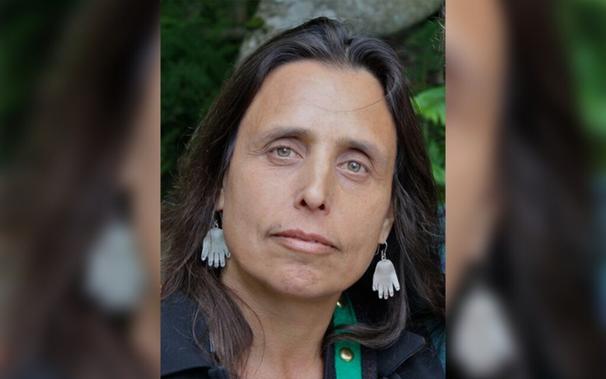#Minnesota #MNWild hosting a historic #Ojibwe #language game broadcast in celebration of #NativeAmerican #Heritage Day
The broadcast will be called by Gordon “Maajiigoneyaash” Jourdain, Ph.D.; Chato “Ombishkebines” Gonzalez; and James “Ginoonde” Buckholtz. #Indigenous
www.nhl.com/wild/news/mi...
Minnesota Wild and FanDuel Spo...
#Ojibwe
2/2
Become our Friend With Benefits on https://patreon.com/OhJoySexToy for exclusive comics and posts that aren't available publicly. Your support directly pays the artists we commission to create these original comics just for our site.
Thank you to our patrons and our sponsor, The Magic Wand, for making this week's comic possible.
#Comic #2Spirit #TwoSpirit #Ojibwe
1/2
Morgan Kagesheongai considers the complex intersection of hair, gender, and culture as a Two-Spirit Ojibwe in this beautiful comic from our archive.
#Comic #2Spirit #TwoSpirit #Ojibwe
𝗪𝗵𝗮𝘁 𝗜’𝗺 𝗥𝗲𝗮𝗱𝗶𝗻𝗴: "𝗧𝗵𝗲 𝗦𝗲𝘃𝗲𝗻 𝗚𝗲𝗻𝗲𝗿𝗮𝘁𝗶𝗼𝗻𝘀 𝗮𝗻𝗱 𝘁𝗵𝗲 𝗦𝗲𝘃𝗲𝗻 𝗚𝗿𝗮𝗻𝗱𝗳𝗮𝘁𝗵𝗲𝗿 𝗧𝗲𝗮𝗰𝗵𝗶𝗻𝗴𝘀" 𝗯𝘆 𝗝𝗮𝗺𝗲𝘀 𝗩𝘂𝗸𝗲𝗹𝗶𝗰𝗵 𝗞𝗮𝗮𝗴𝗲𝗴𝗮𝗮𝗯𝗮𝘄
Brief but reflective, Vukelich explores the meaning of Ojibwe language and suggests that the greatest wisdom of the indigenous peoples exists within the words themselves. Personal and compelling, and very open to newcomers to First Nations wisdom.
«A #Catholic org recently returned land 2 an #Ojibwe tribe in northern #Wisconsin, marking what offcls r calling 1st known return of Catholic-owned land 2 #Indigenous tribe as act of reparations
#FranciscanSisters of Perpetual Adoration on Oct. 31 formally transferred its #Marywood Franciscan Spirituality Center property..on the shores of #TroutLake .. to #LacDuFlambeau #OjibweNation, which has reservation about 6 miles away. Marywood was a retreat for the sisters»
During this nightmare regime of hate & cruelty…
(the #trump admin)
Acts of faith & restoration still happen:
“Officials w/the Franciscan Sisters of Perpetual Adoration said they have been wanting to reckon w/the #history of the #school for some time, & returning the Marywood property to an #Ojibwe #tribe is the start of that.
“It was painful to address our complicity, but we knew it had to be done…”
“We wanted to leave a legacy of healing.”
-Sister Eileen McKenzie
#pictographs #BWCA #quetico #late_woodland #ojibwe
From Quetico Superior Wilderness News
Paddling through time: visiting Crooked Lake pictographs by Pam Wright
https://queticosuperior.org/paddling-through-time-visiting-crooked-lake-pictographs/
“Weapons of Health Destruction...” How Colonialism Created the Modern Native American Diet
The Impact of Systematic Oppression on Indigenous Cuisine in the United States
#Frybread, sometimes called “#DieBread” or a “weapon of health destruction,” has multiple origin stories, and they all involve oppression and perseverance.
by Andrea Freeman, July 24, 2024
Excerpt: "On the hit television show #ReservationDogs, the only series ever to feature all #Indigenous writers, directors, and main cast members, the Indian Health Center invites rapper Punkin’ Lusty, played by real-life #Mvskoke rapper #StenJoddi, to perform his hit song '#GreasyFrybread.' [A song Dr. Lowry played during today's broadcast.] The occasion is #Diabetes Awareness Month. Lusty raps,
Baby girl looking deadly (Yeah!)
Why she acting all Rezzy (Yeah!)
Hotter than a pan of frybread grease!
Have a Native hittin’ Powwow Beats!
Gotcha Auntie in the kitchen
Like no he didn’t
Got her Gramama’s skillet
Like she ’bout to kill it!
The song solidly locates frybread within Indigenous culture.
Sofkee [a corn drink or soup] on the burner
Hokte Hokte [woman] head turner
Water baking powder
Choppin’ up that white stuff
All purpose flour
Gotta mix it right up
Hit the Rez with the Shits
They eats it right up! Watch the grease pop
Watch her waist drop
She got that blue bird bag [Blue Bird flour comes in a twenty-pound cloth bag and claims to be “The Native American Frybread Secret”]
In her tank top
he got that white powder
All over everything
She gettin’ to bussin’ man
But we ain’t cousins man!
We from the same tribe
But a different clan
She my Rez Bunny
And I’m her Red Man
She love my Tattoos
And my two braids
Frybread money at the Creek Fest get paid! On that!”
Foregrounding this song in the Health Center’s battle against diabetes underscores the other side of frybread’s legacy, also emblazoned on a T-shirt that announces 'Frybread: Creating #Obesity Since 1860.' #Cheyenne and #HudulgeeMuscogee #IndigenousRights activist #SuzanShownHarjo, who vowed to give up frybread as a New Year’s resolution, explains, 'Frybread is emblematic of the #LongTrails from home and freedom to confinement and #rations. It’s the connecting dot between healthy children and obesity, #hypertension, diabetes, #dialysis, #blindness, #amputations and #SlowDeath.' Reflecting on stereotypes that dehumanized Indigenous people to justify #colonization, such as the worn-out trope of Indians drinking 'firewater,' Harjo asserts that frybread love is another way to portray them as 'simple-minded people who salute the little grease bread and get misty-eyed about it.'
"In The #HeartbeatOfWoundedKnee, scholar #DavidTreuer introduces health educator #ChelseyLuger, who is #Ojibwe and #Lakota. Chelsey talks to Indigenous communities about the perils of frybread as part of her efforts to steer their diets in new directions, even in the face of limited food options. 'Sometimes people get defensive, but we are able to make the conversation positive. We say we grew up with it and like it and we say frybread is not power. We say frybread kills our people. It’s that serious. It causes diabetes and heart disease. We have to look at those colonial foods as a kind of enemy.' "
#colonization #Colonialism #Decolonize #NativeAmericans #TraditionalFoods #FoodInsecurity #FoodSovereignty #IndigenousFoodSovereignty #Comods #CommodityBoxes #CulturalErasure
by Jessica Milgroom
"Wild rice is a food of great historical, spiritual, and cultural importance for Ojibwe people. After #colonization disrupted their #TraditionalFoodSystem, however, they could no longer depend on stores of wild rice for food all year round. In the late 1950s and early 1960s, this traditional staple was appropriated by white entrepreneurs and marketed as a gourmet commodity. Native and non-Native people alike began to harvest rice to sell it for cash, threatening the health of the natural stands of the crop. This lucrative market paved the way for domestication of the plant, and farmers began cultivating it in paddies in the late 1960s. In the twenty-first century, many Ojibwe and other Native people are fighting to sustain the hand-harvested wild rice tradition and to protect wild rice beds.
"Ojibwe people arrived in present-day Minnesota in the 1600s after a long migration from the east coast of the United States that lasted many centuries. Together with their #Anishinaabe kin, the #Potawatomi and #Odawa, they followed a vision that told them to search for their homeland in a place 'where the food floats on water.' The Ojibwe recognized this as the wild rice they found growing around Lake Superior (#Gichigami), and they settled on the sacred site of what is known today as #MadelineIsland (#Mooningwaanekaaning).
"In the Ojibwe language, wild rice (Zizania palustris) is called #manoomin, which is related by analogy to a word (minomin) meaning 'good berry.' It is a highly nutritious wild grain that is gathered from lakes and waterways by canoe in late August and early September, during the wild rice moon (manoominike giizis).
"Before contact with Europeans and as late as the early twentieth century, Ojibwe people depended on wild rice as a crucial part of their diet, together with berries, fish, meat, vegetables, and maple sugar. They moved their camps throughout the year, depending on the activities of seasonal food gathering. In autumn, families moved to a location close to a lake with a promising stand of wild rice and stayed there for the duration of the season. Men hunted and fished while women harvested rice, preparing food for their families to eat throughout the following winter, spring, and summer."
Read more:
https://www3.mnhs.org/mnopedia/search/index/thing/wild-rice-and-ojibwe
#TraditionalFoods #WildRiceHistory #NativeAmericanHistory #FoodHistory #IndigenousPeople #IndigenousPeoplesDay #FoodSovereignty
Oil Pipeline Threatens Catastrophe for Tribes in Michigan – Again
In 2010, an Enbridge pipeline burst. Tribes are concerned about another one built without their permission 72 years ago.https://murica.website/2025/10/oil-pipeline-threatens-catastrophe-for-tribes-in-michigan-again/
Il mito della lince-drago che riecheggia nelle grotte del lago Superiore
https://www.jacoporanieri.com/blog/?p=43202
#creature #leggende #mostri #territorio #laghi #america #nordamerica #grandilaghi #lagosuperiore #ojibwe #tribù #nativi #indiani #storie #mitologia #pericolo #vendette #acqua #misteri #criptidi #esploratori #risorse #grotte #viaggi #dalmondo
'Muistelmat odzibwe/ᐅᒋᑉᐧᐁ-isoäidin oppimisista uudelleensijoittamisen aikaan
"A memoir of lessons learned from an #Ojibwe grandmother during the time of Relocation"
#HumanRights #RuleOfLaw
https://www.upress.umn.edu/9781452973548/sugar-bush-babies/
https://en.wikipedia.org/wiki/Ojibwe
Bah! My old #fabric supplier is only shipping within Canada. Time to either move back... or find elsewhere to by yards or bolts from.
old:
formally called: Pogadakamagizowin
https://creatorsgifts.ca/
potentials...:
https://powwowsupply.com/
https://49dzinewholesale.com/en-us/
and I have no idea where else. 🤔🧐 Most of these places outsource the actual manufacturing to Korea or elsewhere or are not #Native Owned.
Not really a concern at the moment as I still have plenty waiting to be used. Makes them extra special and limited editions! 😜
#Ojibwe #Blackfoot #KainaiNation #Indigenous #indigenouscreatives #sewing #DIYclothing #smallbusiness #FreakAWear
Vanessa Fuller (#Ojibwe), center-right in sunglasses, participates in a powwow grand entry in the 1990s. She served on the board of the American Indian Center and helped to erganize events such as Miss Indian Chicago, and she was also a combat veteran of the #KoreanWar. Even though Vanessa did not label herself as such, she is remembered as a rolo modal by
The value of wild rice in Minnesota https://www.rawchili.com/nhl/208848/ #Hockey #Indigenous #minnesota #MinnesotaWild #MinnesotaWild #NHL #OJIBWE #WHITEEARTHRESERVATION #wild #WINONALADUKE
Nuclear Pantheon # 1, by Frank Big Bear, Jr., an #Ojibwe artist. 1995.
Choose 20 paintings that have stayed with you or influenced you — one painting per day for 20 days, in no particular order. No explanations, no reviews, just paintings. 11/20
#fediartchallenge #blueskyartchallenge #art #paintings #nativeamericanart
#MichiganMade #MichiganGirl #Ojibwe #IndigenousWoman #Boudoir #PrettyEyes #SoftSmile
by Jessica Milgroom
"Wild rice is a food of great historical, spiritual, and cultural importance for Ojibwe people. After colonization disrupted their traditional food system, however, they could no longer depend on stores of wild rice for food all year round. In the late 1950s and early 1960s, this traditional staple was appropriated by white entrepreneurs and marketed as a gourmet commodity. Native and non-Native people alike began to harvest rice to sell it for cash, threatening the health of the natural stands of the crop. This lucrative market paved the way for domestication of the plant, and farmers began cultivating it in paddies in the late 1960s. In the twenty-first century, many Ojibwe and other Native people are fighting to sustain the hand-harvested wild rice tradition and to protect wild rice beds.
"Ojibwe people arrived in present-day Minnesota in the 1600s after a long migration from the east coast of the United States that lasted many centuries. Together with their #Anishinaabe kin, the Potawatomi and Odawa, they followed a vision that told them to search for their homeland in a place 'where the food floats on water.' The Ojibwe recognized this as the wild rice they found growing around Lake Superior (Gichigami), and they settled on the sacred site of what is known today as Madeline Island (#Mooningwaanekaaning).
"In the Ojibwe language, wild rice (Zizania palustris) is called manoomin, which is related by analogy to a word (minomin) meaning 'good berry.'” It is a highly nutritious wild grain that is gathered from lakes and waterways by canoe in late August and early September, during the wild rice moon (manoominike giizis).
"Before contact with Europeans and as late as the early twentieth century, Ojibwe people depended on wild rice as a crucial part of their diet, together with berries, fish, meat, vegetables, and maple sugar. They moved their camps throughout the year, depending on the activities of seasonal food gathering. In autumn, families moved to a location close to a lake with a promising stand of wild rice and stayed there for the duration of the season.
[...]
RESTORATION AND REGULATION
"As far back as the 1930s, the health of wild rice beds has been a serious concern. In 1939 Minnesota passed a law outlawing mechanized harvest and limiting how and when wild rice could be harvested. Since then, it has enacted other protective policies, including limiting the number of hours in the day during which it is permissible to rice and limiting the length of the canoe used for ricing. In the 1990s, wild rice was identified as an endangered food. The plant is sensitive to water levels altered by dams as well as road construction, pollution, poor harvesting practices, invasive species, genetic engineering (genetic contamination of the wild rice from the paddies), and climate change.
"In response to these threats, Ojibwe and other Native people organized. For example, in 1994, the Fond du Lac and Bois Forte bands developed a '#WildRiceRestorationPlan for the St. Louis River Watershed' designed to restore lost stands of the crop and manage its harvest. In the same decade, the company Native Harvest (part of the White Earth Land Recovery Project) began to sell hand-harvested wild rice, and multiple bands formed reservation wild-rice committees to manage harvests.
"In the 2020s, Ojibwe people continue to defend and protect this vital plant and the cultural, health, and spiritual importance that it holds. Individuals as well as tribes organize ricing camps to teach traditional practices of ricing, parching, and finishing. Others are actively fighting against the Enbridge #Line3 #OilPipeline replacement project that would cross wild rice habitat, or collaborating in a movement for Native food sovereignty."
https://www3.mnhs.org/mnopedia/search/index/thing/wild-rice-and-ojibwe
#SolarPunkSunday #FoodSovereignty #WaterIsLife #FoodIsLife #NativeAmericanFoodSovereignty #FoodSovereignty #Foodsecurity #TraditionalFoods #IndigenousPeoplesDay #IndigenousFood
"For many, summertime activities such as boating and swimming are first to mind when visiting Big Sandy Lake near McGregor in northern Minnesota. However, to several generations of Ojibwe people, the shoreline of the lake is described as a “graveyard.” https://www.mprnews.org/story/2025/08/07/they-are-remembered-hundreds-gather-to-honor-ojibwe-who-died-175-years-ago
NOTE: My great grandfather built a log cabin on Big Sandy Lake; before that, he and his father in law (i.e., my great, great grandfather) would set up tents to camp and fish.
Great Lakes tribes teach 'water is life.’ But they’re forced to fight for its protection
by Caitlin Looby and Frank Vaisvilas
Nov. 29, 2023
LAC DU FLAMBEAU, Wis. – "John Johnson, president of the #LacDuFlambeau #Ojibwe Tribe in northern #Wisconsin, is not one to hold back his frustrations with the #Wisconsin Department of Natural Resources over management of the waterways in the Northwoods.
" 'We used to be able to drink water right out of this lake when we were kids,” he
said while looking over Pokegama Lake from a balcony at the tribe’s hotel-casino. 'We can’t now.'
"While the tribe does what it can to keep the lake clean, it can’t control what happens outside the reservation to waters that eventually flow in.
"The DNR 'won’t listen to #NativeAmericans,' Johnson said. For many tribes around the Great Lakes basin, water is considered a sacred spirit.
Ojibwe teachings say that 'WaterIsLife' – a phrase that encapsulates the
interconnected relationships that water has with every living thing on Earth.
"Now the phrase is often seen on signs at protests – ones where tribes are fighting
against massive, corporate oil and mining projects that threaten to pollute
waterways."
Archived version:
https://archive.ph/l81HJ
#WaterIsLife #NibiBimaadiziwin #BigOilAndGas #CorporateColonialism #CorporatePolluters #NoMiningWithoutConsent

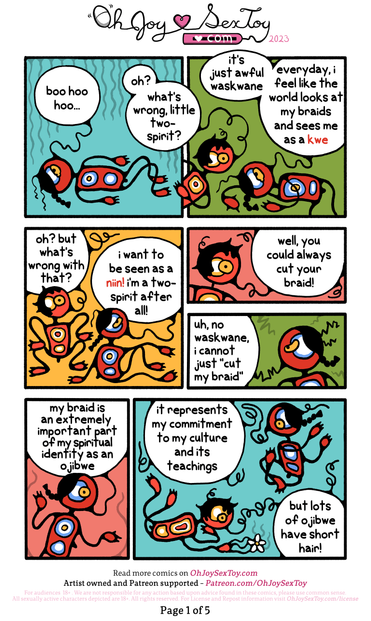
![WASKWANE (sharing a growing flower between the two of them): would you call them less spiritually committed? TWO-SPIRIT (now growing a leafy vine by themself): of course not! everyone's journey with spiritualism and culture is different. it's just that i feel most connected to my own journey when i have my braid and i don't want to lose that WASKWANE:even though it's causing you to feel at odds with your gender identity? TWO-SPIRIT (a single leaf grows from their finger): yes WASKWANE: goodness little two-spirit, that is a lot! those are two very important aspects of your identity in conflict with one another. i don't know if there's anyone who can say which decision is the right one... TWO-SPIRIT: so then what do i do? WASKWANE: well, i have to ask the obvious: have you tried reaching out to an elder yet? [Waskwane's stomach grumbles "hungryyy"]](https://files.mastodon.social/media_attachments/files/115/567/148/215/363/980/small/11e2baceb66a3109.png)
